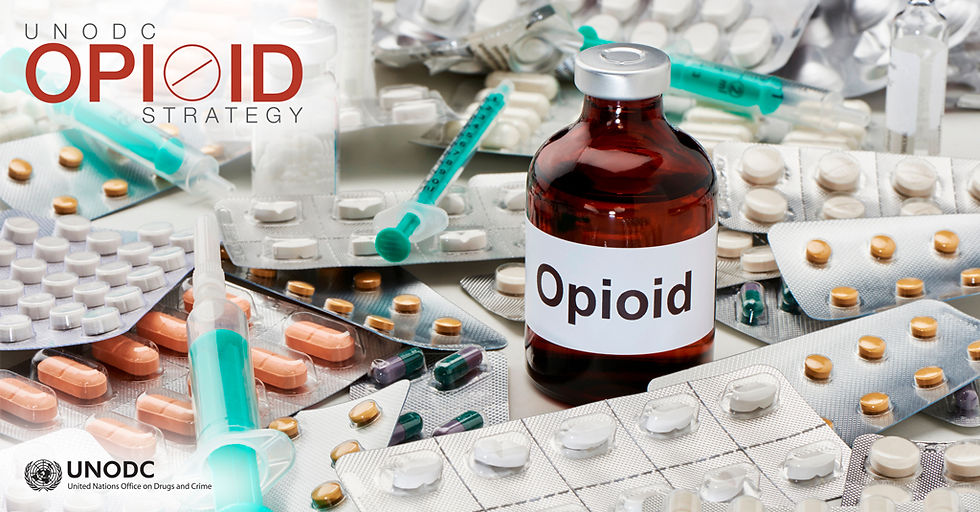“It only takes a little to lose a lot.”The term "Opioid Crisis" refers to a serious public health concern and issue that has resulted in a rapid increase in the use of prescription and non-prescription opioid drugs. Opioid medication is a type of prescription drug that is used to relieve pain and produce feelings of calmness and relaxation. The medication works by binding to brain and spinal cord receptors. Moreover, Opioid Crisis is widely recognized as one of the most devastating public health disasters in history, and even in modern times. To begin, the Opioid Crisis began in the mid-1990s, when OxyContin, one of the Opioid drugs, was promoted by Purdue Pharma and approved by the FDA, also known as the Food and Drug Administration. It is also known as the first wave of death as a result of the illegal prescription of opioid drugs such as OxyContin, Hydrocodone, and Fentanyl. The pandemic has exacerbated this crisis, which has been linked to factors such as COVID-19 anxiety and a lack of quality care access (ipfcc).

Fig. 1. “UN responds to the global Opioid crisis.” |
As far back as the late 1990s, pharmaceutical companies assured the medical community that the drugs associated with opioids were not addictive or harmful, and were instead used for pain relief. However, it quickly became clear that opioids were highly addictive, even when used as prescribed. Furthermore, it is well known that medical companies have aggressively engaged in marketing campaigns, making people addicted to purchasing more Opioid drugs on the market. According to the National Safety Council, children as young as 15 years old have died as a result of the opioid crisis. Furthermore, approximately 7/10 males died as a result of their Opioid crisis consumption.Female deaths total 53,992 compared to 21,793 female deaths in 2021. Despite this disparity in death rates, female deaths from the opioid crisis have been increasing at a faster rate since 1999 (Drug Overdose).

Fig. 2. “Tens of thousands of Americans die each year from opioid overdose.” |
|---|
Fentanyl, one of the drugs associated with the Opioid Crisis, can have an immediate effect. Researchers have also discovered that smelling and consuming a pinch of Fentanyl has a high probability of killing you. As the Opioid crisis continues, there are several factors that are a leading cause of the Opioid drugs that are rapidly growing. First, the medical community claims that opioid drugs are safe, which quickly convinces society that it is not harmful and is beneficial to your health. Second, the pharmaceutical industry, which minimizes the risks of addiction while emphasizing its effectiveness. These strategies have the potential to increase not only addiction but also production and profit rates.Third, there are social and economic considerations. Poverty, unemployment, and limited access to healthcare are all socioeconomic factors that contribute to the Opioid Crisis (Staff). The factors can contribute to a sense of hopelessness, which leads to individuals turning to opioids for escape and self-medication. The prescription drug monitoring programs, also known as PDMPs, were implemented to track prescription patterns and prevent "doctor shopping," which occurs when a substance user visits multiple physicians seeking legal prescription to fuel their addiction (Ridgefield).
Opioid risk is similar to HIV risk, which is caused by a virus that attacks the body's immune system. Opioids have also been linked to HIV risk behaviors such as needle sharing and risky sex ("HIV and Substances Use"). Opioids continue to be an epidemic in the United States and around the world. It may affects over 3 million US citizens and 16 million people worldwide (Azadfard, Huecker, and Leaming).
Despite the epidemic's increasing rate, there are several ways to help prevent it. To begin, public education should be promoted through awareness campaigns to educatethe public about opioid abuse. Second, prescription drug monitoring programs (PDMPs) implement and strengthen PDMPs in order to track and control the substances. This enables us to identify individuals who may be doctor shopping or receiving an excessive number of opioid prescriptions. Third, improved collaboration among healthcare providers to encourage communication, including primary care and specialists. Finally, address social determinants of health, such as poverty by underlying issue and its potential risk factors.
Opioids are slowly killing people. As a result, governments all over the world begin to contribute to education and funding. Since February 2017, the Canadian government has committed more than $800 million to combating the opioid overdosecrisis. Community and organization funding for a project through the Substances Use and Addiction Program to support people addicted to illegal drugs ("Federal actions on Opioids to date").
To summarize, eradicating the opioid crisis requires a comprehensive and collaborative approach involving multiple stakeholders. If not eliminated soon, illegal drugs will take more lives than we can imagine. There are already ways to prevent it, as well as addressing social health factors and collaborating with law enforcement. It is possible to reduce the risk of Opioid drug misuse and addiction by implementing these strategies.
Citation
“Am I Vulnerable to Opioid Addiction?” Mayo Clinic, 12 Apr. 2022, www.mayoclinic.org/diseases-conditions/prescription-drug-abuse/in-depth/how-opioid-addiction-occurs/art-20360372#:~:text=Known%20risk%20factors%20of%20opioid,Family%20history%20of%20substance%20abuse. Accessed 21 June. 2023.
Canada, Health. “Government of Canada.” Canada’s Opioid Crisis (Fact Sheet) -Canada.Ca, 9 Apr. 2019, www.canada.ca/en/health-canada/services/publications/healthy-living/canada-opioid-crisis-fact-sheet.html. Accessed 21 June. 2023.
Canada, Health. “Government of Canada.” Federal Actions on Opioids to Date -Canada.Ca, 16 June 2023, www.canada.ca/en/health-canada/services/opioids/federal-actions/overview.html. Accessed 25June. 2023.
“Drug Overdoses.” Injury Facts, 1 Mar. 2023,injuryfacts.nsc.org/home-and-community/safety-topics/drugoverdoses/#:~:text=Few%20opioid%20deaths%20occur%20among,females%20versus%201%2C076%25%20for%20males. Accessed 20June. 2023.
“HIV and Substance Use.” Centers for Disease Control and Prevention, 21 Apr. 2021, www.cdc.gov/hiv/basics/hiv-transmission/substance-use.html#:~:text=Opioids%2C%20a%20class%20of%20drugs,to%20a%20recent%20HIV%20outbreak. Accessed 25June. 2023.
“How Doctor Shopping Spurs the Opioid Crisis: The Recovery Village Ridgefield.” Ridgefieldrecovery, 26 May 2023, www.ridgefieldrecovery.com/drugs/opioids/how-doctor-shopping-spurs-opioid-crisis/#:~:text=%E2%80%9CDoctor%20shopping%E2%80%9D%20is%20when%20a,stemming%20from%20legally%20prescribed%20opioids. Accessed 25June. 2023.
Opioid Addiction -Statpearls -NCBI Bookshelf, www.ncbi.nlm.nih.gov/books/NBK448203/. Accessed 25 June 2023.
“Un Responds to the Global Opioid Crisis | ةدحتم ل ا مملأا.” United Nations, www.un.org/ar/node/134031. Accessed 25 June 2023.

Comments